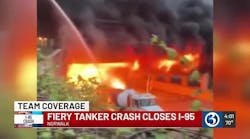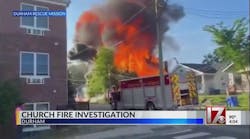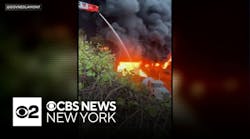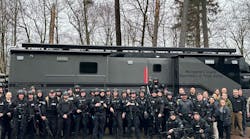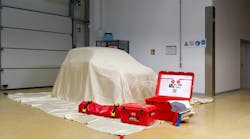Size-up is the mental imaging of many pieces of information gathered as the alarm is initiated, when enroute and while at the incident. Size-up is continuous and essential to a successful fire-attack plan. All firefighters should participate in size-up on a regular basis.
While enroute to a structural wildland interzone (SWI) fire, think about:
- Safety!
- Are we first in?
- Are we assigned to a task force and/or going to a staging area?
- Your own state of preparedness, i.e., PPC, equipment, health and fitness and your crew's experience.
- Where the fire is located, i.e., types of wildland fuels, terrain and topography of area.
- Weather conditions, i.e., temperature, humidity, wind speed, direction and time of day.
- Has it been dry for any length of time?
- Fire history of the area.
- Time of the year. Is it wildfire season?
- Types of structures in the area.
- Water supplies.
- Road access and the best way into area or to staging.
- Is the column of smoke visible in the day? Is there a red glow at night? What does it look like ahead?
- What is the radio traffic stating?
While operating, think about:
- Safety!
- Do you have sufficient help to handle the incident?
- Remember the acronym L C E S (see part 1, April 1998).
- Rescue or evacuation of people, domestic pets and/or livestock.
- Give a radio report and be as specific as you can.
- Water supplies (should you hook up to a hydrant, if available, or stay mobile?).
- Water tanker/tender setup.
- Structures, i.e., types, numbers, spacing, construction, wood-shake-shingled roofs?
- Perform "structure triage" if necessary (more on this later).
- Current fire behavior, i.e., where is it, the direction and rate of spread, fire brands and/or ash falling?
- Vegetation fuels around structures and beyond them. How close, dry, dense?
- Special hazards, i.e., chemicals both known and unknown; electric power lines; cul-de-sacs and dead end roads; roads and long driveways that are very narrow; fleeing people and animals evacuating down dark and/or smoke-filled escape routes; bridges that are too low for the engine to get under or unable to hold weight of engine and unfamiliar areas where you could get lost.
- Insects that can sting or bite, wasps, bees, etc.
- Venomous snakes.
- Poison ivy, oak and sumac when burning give off toxic smoke. Rubbing against these plants can cause severe allergic reactions.
- Falling trees and snags. These can be deadly hazards. Trees that have been burning at their lower areas can suddenly and quickly fall onto personnel causing severe crushing injuries or death. Burning tree limbs can also fall onto unsuspecting personnel with the same results.
- Burning trash piles and dump fires can give off toxic smoke from buried hazardous materials.
- Don't wear rubber structural turnout boots at wildland fires. They cause rapid fatigue, blisters and muscle cramps. They also make running nearly impossible if you must escape from a fast-moving fire.
- Tall grasses, brush and "flashy" fuels can be deceptively dangerous. Don't walk into these potentially dangerous fuels. Shifting winds can increase the size, intensity and direction of fire travel very rapidly causing fire entrapment of personnel. Attack from the black or burned area of a fire.
- Watch out for other emergency vehicles.
- Personal alert safety system (PASS) devices are not just for structural fire operations. While operating at a wildland or SWI fire, wear your PASS device and don't forget to activate it. Also, remember to use your fire department's accountability SOPs. And finally, do not "freelance" or become separated at a fire incident. Use the group or buddy system; the 2 in/2 out rule is in effect.
Structural Triage
This is the size-up and prioritizing of structures in the structural wildland interzone, a/k/a wildland urban interface. The object is to do the most good with what resources one has at and is responding to the incident.
There are three categories of structural triage:
- Structures that are basically secure and require little or no protective action.
- Structures that require protective action but are savable with adequate resources and are called "winners."
- Structures that are not savable and are called "losers."
Factors that affect structural triage decisions are:
- The structure itself.
- Roof-combustible or not.
- Is roof and/or gutters covered with dry needles or leaves.
- Siding-combustible or not.
- Heat traps-Open gables, vents with no screens, wooden decks, porches.
- Windows-size, single or double glazed, shuttered.
- Size and shape of structure.
- Position of structure on site - is it sitting on a slope, over a saddle, etc.
- Wildland fuels.
- Size, type, arrangement, age, fuel loading, dryness, proximity to structure. Is there a "defensible space" of at least 30 to 100 feet around the structure?
- Fire behavior, rate of fire spread, topographic influences, present/predicted weather conditions, flame lengths, is fire spotting, torching or crowning and coming in your direction?
- Firefighter safety.
Access/egress routes for quick escape, evacuees fleeing, power lines, hazardous materials, LPG and other fuels, pesticides, heavy smoke obscuring visibility, heat exhaustion, panicked animals, open wells, septic tanks, products of combustion and entrapment by fast-spreading heavy fire conditions.
(To be continued.)
Robert M. Winston, a Firehouse® contributing editor, is a district fire chief in the Boston Fire Department with extensive experience and training in wildland and SWI protection. Part 1 of this column was published in the April 1998 issue.


